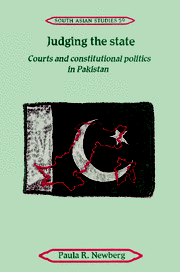Book contents
- Frontmatter
- Contents
- Preface
- Introduction
- 1 Structuring the state
- 2 Constituting the state (1947–1958)
- 3 Confining courts and constitutions (1958–1969)
- 4 Seeking justice (1969–1972)
- 5 Testing courts and constitutionalism (1972–1977)
- 6 Silencing courts, muting justice (1977–1988)
- 7 Reviving judicial powers (1988–1993)
- 8 Judging the state
- Table of cases
- Bibliography
- Index
- Cambridge South Asian Studies
3 - Confining courts and constitutions (1958–1969)
Published online by Cambridge University Press: 06 January 2010
- Frontmatter
- Contents
- Preface
- Introduction
- 1 Structuring the state
- 2 Constituting the state (1947–1958)
- 3 Confining courts and constitutions (1958–1969)
- 4 Seeking justice (1969–1972)
- 5 Testing courts and constitutionalism (1972–1977)
- 6 Silencing courts, muting justice (1977–1988)
- 7 Reviving judicial powers (1988–1993)
- 8 Judging the state
- Table of cases
- Bibliography
- Index
- Cambridge South Asian Studies
Summary
Flowers are blooming again, you say
Thirsts are quenched again, you say
Wounds are healed again, you say.
I deny your open lies, I contest your looting of minds.
For centuries you have robbed us of our peace of mind.
Your magic will not work on us now.
How am I now to call you a saviour?
A saviour you are not, though some still say you are.
I say no, I say no.
Habib Jalib, “Dastur.”There are quite a few thousand men who would rather have the freedom of speech than a new suit of clothes and it is these that form a nation, not the office hunters, the licenses, even the tillers of the soil and the drawers of water.
Justice M.R. KayaniThe 1956 Constitution ushered in a short period of constitutional rule but the constitution's roots were also its shortcomings, which in turn compounded political instabilities across the country. The Assembly accepted indirect rule, One Unit and the strong executive required by the Governor-General and produced a constitution confirming the structure of the vice-regal state. The constitution transferred the Governor-General's powers to the President, limited parliamentary rule and offered little challenge to the powerful army or the bureaucracy. Fundamental rights were incorporated into the constitution, however, and the superior courts were guaranteed both their independence and the right to issue the full range of writs.
- Type
- Chapter
- Information
- Judging the StateCourts and Constitutional Politics in Pakistan, pp. 69 - 109Publisher: Cambridge University PressPrint publication year: 1995

